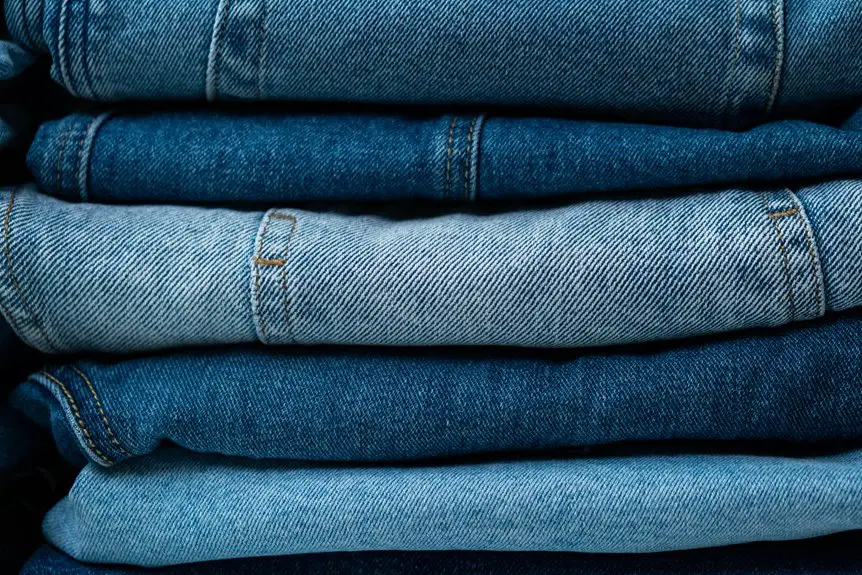To stop dye transfer from dark clothes to light clothes, always wash in cold water, as heat can activate dyes and lead to bleeding. Separate lights and darks, and pre-wash new garments to prevent color release. Use gentle wash cycles and avoid overcrowding the washer to minimize friction. Monitor fabric conditions regularly for signs of fading or damage. You’ll also discover tips for handling different fabrics and professional cleaning options that can help protect your clothes even further.
Table of Contents
Key Takeaways
- Always separate light and dark colors before washing to prevent dye transfer.
- Use cold water for washing, as it reduces dye activation and bleeding.
- Pre-wash new garments separately to avoid releasing excess dye.
- Consider using color catcher sheets to capture loose dyes during the wash.
- Consult a professional cleaner for delicate or vintage items to ensure safe cleaning.
Understanding Dye Transfer and Its Causes
Dye transfer occurs when the color from one fabric bleeds onto another, often ruining your favorite clothes. This usually happens due to poor dye quality, where the color isn’t set properly, causing it to release during washing or wearing.
Dye transfer can ruin your favorite clothes when colors bleed due to poor dye quality and improper washing practices.
Dark fabrics, especially, are notorious for this issue. If you wash light and dark clothes together, the risk of dye transfer increases markedly. Heat and agitation in the wash can exacerbate the problem, allowing dyes to escape and adhere to lighter materials.
Additionally, moisture can activate the dye, making it more susceptible to bleeding. Understanding these causes helps you take necessary precautions to protect your wardrobe.
Always be mindful of what you’re mixing in the wash to keep your clothes looking their best.
The Importance of Cold Water Washing
When you wash your clothes in cold water, you greatly reduce the risk of dye transfer. Cold water helps keep the dyes in dark fabrics from loosening and bleeding onto lighter items.
Heat can cause the dye molecules to break down, which increases the chances of staining your favorite whites or pastels. By opting for cold water, you’re not only protecting your lighter clothes but also extending the life of your dark garments.
Most detergents work effectively in cold water, ensuring your clothes still come out clean without the added risk. Plus, washing in cold water is energy-efficient, helping you save on utility bills while being kinder to the environment.
Gentle Wash Cycles for Color Preservation
To preserve the vibrant colors of your clothes, using gentle wash cycles is essential. These cycles help reduce friction and agitation, which can cause fading and dye transfer. When you choose a gentle cycle, you’re protecting your garments and extending their lifespan.
Here’s a quick comparison of wash cycles for color preservation:
| Cycle Type | Agitation Level | Ideal For |
|---|---|---|
| Gentle Cycle | Low | Delicate fabrics |
| Regular Cycle | Moderate | Everyday fabrics |
| Heavy Duty Cycle | High | Sturdy, durable items |
Sorting Clothes: Lights, Darks, and Fabrics
When you sort your laundry, make sure to separate light and dark colors to prevent any unwanted dye transfer.
Group similar fabrics together, too, as this helps maintain the integrity of each item.
These simple steps can save your clothes from color mishaps and keep them looking their best.
Separate Light and Dark
Sorting your laundry into lights and darks is essential for preventing dye transfer. By keeping these colors separate, you minimize the risk of your light clothes picking up unwanted colors from darker garments.
Here’s how to make sorting simple:
- Light Clothes: Whites, pastels, and light-colored fabrics.
- Dark Clothes: Deep hues like black, navy, and dark red.
- Brights: Vibrant colors that may bleed, so sort them with darks.
- New Items: Always wash new clothes separately to avoid initial dye release.
- Check Labels: Some fabrics may require special care, so read the tags before washing.
Group Similar Fabrics
Grouping similar fabrics together is a smart way to further reduce the risk of dye transfer and damage during washing. When you wash delicate items, like silk or lace, keep them separate from heavier fabrics, such as denim or towels. This not only protects fragile materials but also helps prevent friction that can lead to pilling or wear.
Additionally, mixing fabrics can create uneven washing conditions. For example, heavier items may not clean as effectively with lighter fabrics. By sorting your laundry based on fabric type, you guarantee a more effective wash cycle.
Always check care labels for specific instructions, too. Taking the time to group your clothes wisely can save you from potential dye mishaps and extend the life of your wardrobe.
Initial Washing: Best Practices for New Garments
When you bring home new garments, it’s essential to pre-wash them to prevent any unwanted dye transfer later on.
Before tossing them in with your regular laundry, test for color bleed by soaking a small corner in water.
This simple step can save you from a laundry disaster down the line.
Pre-Wash New Garments
Pre-washing new garments is essential to prevent dye transfer and protect your wardrobe. By taking this simple step, you can save your light-colored clothes from unwanted stains.
Here are some best practices for pre-washing:
- Use cold water: It helps prevent colors from bleeding.
- Add a cup of white vinegar: This can help set the dyes.
- Turn clothes inside out: It minimizes direct contact with other fabrics.
- Wash similar colors together: Keep darks separate from lights to avoid dye transfer.
- Air dry: This method reduces shrinkage and avoids heat setting any potential stains.
Following these tips guarantees your new clothes stay vibrant and your wardrobe remains safe from dye mishaps!
Test for Color Bleed
After pre-washing your new garments, it’s wise to test for color bleed before wearing or washing them with other clothes.
To do this, take a small, inconspicuous area of the fabric and dampen it with water. Next, press a white cloth or paper towel against the dampened spot. If you see any color transfer on the white cloth, your garment may bleed.
In that case, consider washing it separately in cold water or adding a color catcher sheet to future washes. This simple test can save you from unwanted dye transfer and protect your lighter clothes.
Always remember, it’s better to be safe than sorry when it comes to preserving your wardrobe!
Specialized Products to Prevent Dye Bleeding
To keep your clothes looking vibrant and free from dye transfer, consider using specialized products designed to prevent dye bleeding. These products can make a significant difference in maintaining the integrity of your wardrobe.
Here are a few options to explore:
- Color Catcher Sheets: These sheets absorb loose dye in the wash, protecting lighter clothes.
- Dye Fixatives: Use these to treat new fabrics, ensuring the dye stays put during washes.
- Fabric Softeners: Some formulas help lock in color while softening your clothes.
- Washing Pods: Look for pods specifically formulated to prevent dye transfer.
- Laundry Detergents with Color Protection: These are designed to minimize color fading and bleeding.
Incorporating these products into your laundry routine can help you enjoy your clothes longer.
Avoiding Overcrowding in the Washer
When you’re loading your washer, remember that size matters.
Overcrowding can lead to increased fabric agitation, which heightens the risk of dye transfer.
To optimize washing efficiency and keep your colors safe, make sure to give your clothes enough space to move freely.
Load Size Matters
While it might be tempting to cram as many clothes as possible into your washing machine to save time, overcrowding can lead to dye transfer and ruined garments. To avoid this, keep your loads manageable.
Here are some tips to help you:
- Separate colors: Always wash darks and lights separately.
- Fill loosely: Make certain there’s enough space for clothes to move freely.
- Check capacity: Know your washer’s load limit and stick to it.
- Use bags for delicates: Protect lighter items by using mesh laundry bags.
- Don’t overload: If in doubt, wash smaller loads to be safe.
Fabric Agitation Control
Proper fabric agitation control is essential for preventing dye transfer and ensuring your clothes stay vibrant.
When you overcrowd your washer, clothes can’t move freely, causing excessive friction. This friction increases the chances of dye bleeding from dark to light fabrics. To avoid this, always load your washer with enough space for items to tumble freely. Aim for a load that’s about three-quarters full, allowing ample room for agitation without cramming.
If you have a large load, consider splitting it in half. Additionally, using a gentle cycle can help minimize agitation while still cleaning your fabrics effectively.
Optimize Washing Efficiency
To keep your clothes looking their best, optimizing washing efficiency involves avoiding overcrowding in the washer. Overloading can cause clothes to rub against each other, increasing the risk of dye transfer.
Here are some tips to help you maintain the right balance:
- Know your washer’s capacity: Check the manual for load limits.
- Separate colors: Wash darks and lights separately to minimize dye risks.
- Use the right cycle: Choose a cycle that suits the load size and fabric type.
- Leave space: Aim for roughly a quarter of the drum empty to allow for movement.
- Don’t cram it in: If you can’t close the lid easily, it’s too full!
Tips for Handling Different Fabric Types
When you’re dealing with different fabric types, knowing how to handle each one can help prevent dye transfer effectively.
Start by sorting your laundry based on fabric type. For example, wash delicate fabrics like silk or wool separately from heavier materials such as denim or cotton.
Sorting your laundry by fabric type is essential; keep delicate items like silk and wool separate from heavier materials like denim and cotton.
Use cold water for all washes, as it helps minimize dye bleeding. When washing dark and light clothes together, consider using a color catcher sheet to absorb excess dye.
Always check care labels for specific washing instructions. For fabrics prone to bleeding, like new dark garments, wash them separately for the first few cycles.
Finally, avoid overloading the washing machine, as this can prevent thorough cleaning and increase dye transfer risk.
Monitoring Fabric Condition for Early Detection
Keeping an eye on the condition of your fabrics plays an essential role in preventing dye transfer. Regular checks can help you spot potential issues before they become a problem.
Here are some signs to watch for:
- Fading Colors: If your dark clothes are losing vibrancy, they may bleed more easily.
- Loose Threads: Fraying edges can lead to dye release during washing.
- Pilling: Fabric pills can indicate wear, increasing the risk of dye transfer.
- Stains: Existing stains can attract dye during washes, causing further transfer.
- Texture Changes: A rough or stiff feel may signal fabric breakdown, heightening dye risks.
Professional Cleaning Options for Delicate Items
While you might be tempted to wash delicate items at home, professional cleaning options often provide the best protection against dye transfer.
Dry cleaners have specialized techniques and solutions designed to handle fabrics that are prone to color bleeding. They can assess your items and choose the right cleaning method, reducing the risk of damage.
Additionally, they often use solvents that effectively remove stains without risking dye transfer. If you’re dealing with vintage or designer pieces, their expertise is invaluable in preserving the integrity of the fabric.
When in doubt, don’t hesitate to consult with a professional cleaner—it’s worth the investment to keep your delicate items looking their best and free from unwanted color bleed.
Frequently Asked Questions
Can I Use Regular Detergent for Dark Clothes?
Yes, you can use regular detergent for dark clothes. Just make sure it’s formulated for colors to help prevent fading. Always check the label for specific washing instructions to keep your clothes looking their best.
How Often Should I Wash Dark Clothes?
Think of your dark clothes like a favorite book. You wouldn’t read it every day to keep it crisp. Wash dark clothes every 5-7 wears, unless they’re stained, to maintain their vibrancy and longevity.
Does Fabric Softener Help Prevent Dye Transfer?
Fabric softener doesn’t prevent dye transfer effectively. It can make clothes feel softer, but it won’t stop colors from bleeding. To protect your lighter garments, consider using color catcher sheets or washing them separately.
What if My Dark Clothes Still Bleed?
If your dark clothes still bleed, think of them as mischievous artists splattering paint. You’ll want to wash them separately, use cold water, and consider color-catching sheets to minimize any dye drama in your laundry.
Can I Mix Different Fabric Types in One Wash?
You can mix different fabric types in one wash, but be cautious. Fabrics like cotton and polyester can often coexist, while delicate materials might snag. Always check care labels to avoid damaging your clothes.
- Will 100% Cotton Percale Wrinkle? The Honest Truth - July 15, 2025
- Why Do Toenails Tear Percale Sheets and How to Prevent It - July 15, 2025
- Why Is Percale Considered a Superior Sheet? - July 15, 2025







